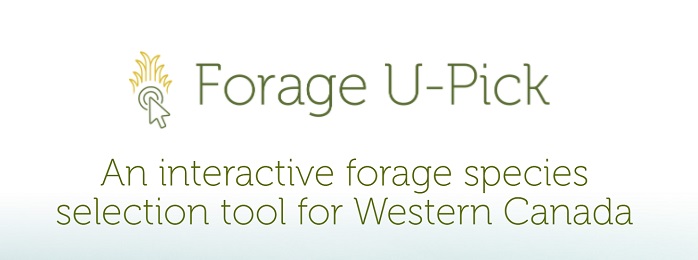Rejuvenation of a forage stand, whether hay or pasture, involves using one or a combination of methods to increase productivity with a shift towards higher yielding forage species that provide improved nutritive value for livestock.
It is important to note that the rejuvenation methods presented below, and discussion of their use, is focused on formerly cultivated or disturbed sites, as opposed to rejuvenation of native rangelands. All remnant stands of native rangeland should be retained and NOT enhanced or replaced with non-native plant species. These areas should always be managed according to sound ecological principles.
Available research results are included where possible throughout this page. For some rejuvenation methods, region-specific information is limited or not available. The BCRC has made every effort to provide as much up-to-date information as possible. Contact a local forage, grazing or cattle association, extension specialist or agrologist in your area to check if additional information specific to your region exists.
| Key Points |
|---|
| Soil moisture is the most important variable when rejuvenating a forage stand and must be considered in timing and method of rejuvenation |
| If a forage stand does need rejuvenation, it is critical to identify the reason for decline in productivity |
| Native rangeland should be retained, with management based on sound ecological principles, and not enhanced or replaced with non-native plant species |
| Grazing management should be the first rejuvenation technique considered. Until any grazing management issues are addressed, no other aspect of rejuvenation will maintain healthy stands |
| A soil test is important to determine soil pH and fertility levels and will identify nutrient deficiencies. Soil test results will help determine the optimum fertilizer application rates in your region for your specific soil type and forage species |
| Mechanical disturbance increases the decomposition of root material, releasing nutrients into the soil and making them available for plant use |
| Selective herbicides can be used to control unwanted plants that are competing with desirable forage species but can be costly, difficult to apply, may harm desirable forage species and may remove sprayed areas from production for a period of time. Herbicide use does not fix long term management or soil issues |
| Mowing can be used to remove unwanted plants providing a competitive advantage to the more desirable forage species, allowing them to make use of nutrients, sunlight and moisture and potentially out compete the less desirable plants |
| Advantages of direct seeding into sod include not exposing the land to erosion, as may occur with breaking and reseeding, plus conservation of available soil moisture, lower costs and the land remaining in production |
| Overseeding a legume into an existing stand is a relatively inexpensive rejuvenation technique however, establishment success is highly dependent upon favourable conditions |
| Significant drawbacks to breaking an established stand and reseeding include the loss of production in the initial year, potential for erosion, loss of soil moisture, and cost |
Newly established forage stands typically have relatively high production and, in the early years, low maintenance requirements. However, over time productivity may decline due to a number of factors, including:
- low productivity soils due to texture, poor drainage, nutrient deficiencies, salinity, acidity or structure
- limited moisture during drought periods or untimely rainfall
- a mismatch of forage species to desired production type, whether pasture, hay or mixed use
- long-term mismanagement (e.g., poor timing of grazing, overutilization, inadequate rest periods that results in loss of desirable species.
Often it is a combination of these factors that results in a significant decline in hay or pasture production.
Deciding Whether to Rejuvenate or Not
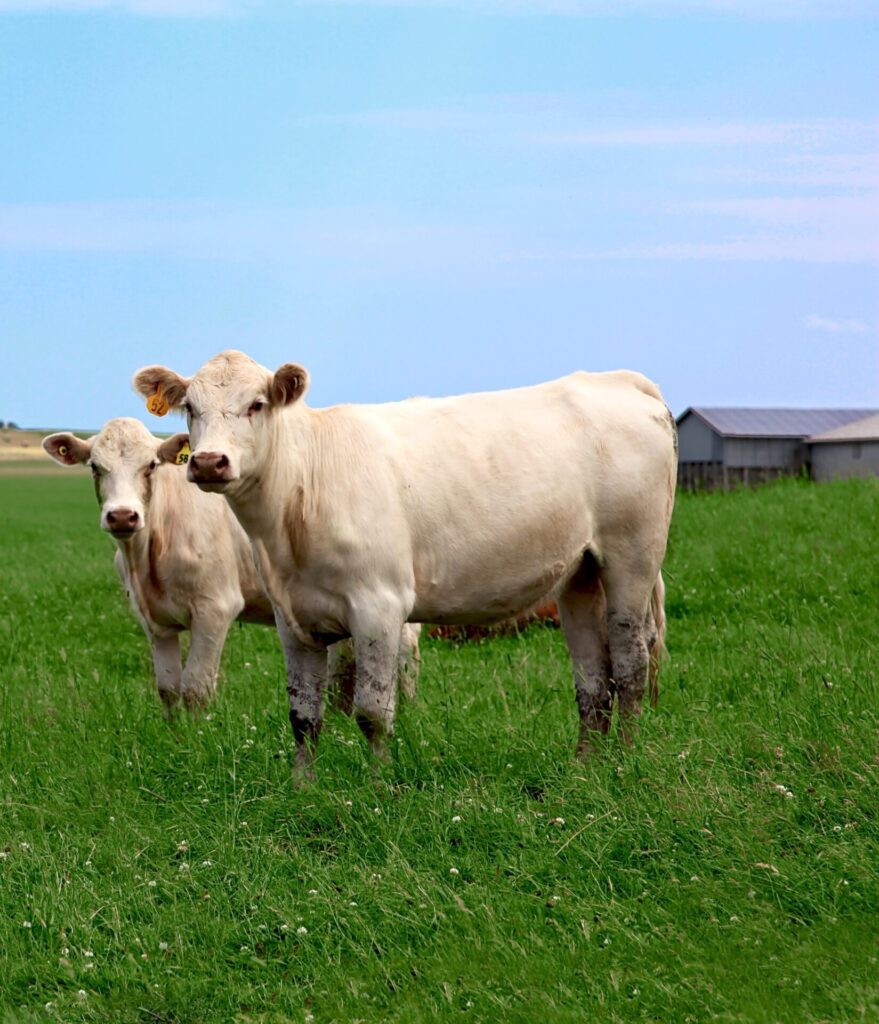
The first step in deciding whether to rejuvenate a forage stand is comparing the potential productivity with the current status of the pasture or hayfield. This will help determine if, and what, improvements or management changes are needed.
A stand assessment starts with evaluation of the current plant population. What desirable plant species are present and quantity of each as compared to undesirable plants? Are there invasive species? Poisonous plants? Are there large areas of bare ground and evidence of erosion? Conducting a pasture or range health assessment is an important first step to identify best options for rejuvenation.
Conduct an honest evaluation of the current forage management system being applied to the area in question. All past management decisions play a part in determining the current condition of the forage stand.
Soil parameters including type, texture, pH and any limitations such as salinity (soil containing soluble salts in quantities that interfere with plant growth) or solonetzic soils (high in sodium with a hardpan layer in the subsoil which is very hard when dry and low permeability when wet) influence forage production. In Eastern Canada, acidic soils frequently result in lowered production due to low soil pH affecting the solubility of nutrients and limiting plant uptake. All of these variables must be factored in when considering a rejuvenation option. By collecting and submitting a soil sample to a lab, you will identify whether key nutrients are lacking and whether fertility and/or soil pH is a limiting factor for optimizing productivity.
Although largely out of a land manager’s control, soil moisture is the most important variable when rejuvenating a forage stand. Moisture status of a pasture or hayfield from the previous growing season as well as forecasted precipitation must factor into the choice of timing and method of rejuvenation. With adequate soil moisture, particularly under irrigation or in high rainfall areas, rejuvenation options become less risky and more cost effective. Sowing forages in the spring can increase the chance of successful establishment as moisture is generally available from snow melt and spring rains. Cooler spring temperatures can help with the establishment of cool season species before higher temperatures cause plant stress or dormancy.
| Evaluating Your Management System |
|---|
| When does grazing occur? |
| What stocking rate is applied? |
| Frequency and level of utilization? |
| Are rest periods provided and are they long enough? |
| What flexibility do I have in my system for unforeseen circumstances? |
| What is the timing and frequency of haycuts? |
Soil moisture is the most important variable when rejuvenating a forage stand.
The Beef Research School video, Maximizing Production on Forage Acres, discusses considerations when deciding whether to rejuvenate a pasture or not (0:44), importance of soil fertility (2:43), logistics of forage seeding if re-establishing a stand (3:44), and grazing management (5:50).
What are the Goals and Objectives of Rejuvenation
Determining the best option for rejuvenation must be based upon long-term overall objectives. The up-front costs for many rejuvenation methods may be significant, therefore careful evaluation and planning are necessary. Questions to consider include:
- How soon are results expected and how long will the effect last?
- How soon do you plan to graze the stand? How long can the paddock or field be kept out of production?
- What is the measure for successful rejuvenation (i.e., increased yield, greater percentage of desired species, removal of invasive species, improved forage quality)?
- How will rejuvenation of an area of land align with the overall annual forage management plan? Will gaps in productivity during specific times of the year be addressed by rejuvenation?
- Is the goal to increase forage yield or change the type of species? What type of forage species are desired?
- What are the limitations of the site (i.e., light vs heavy soils, precipitation)?
- Do you have access to the equipment needed?
- What are the associated costs and potential return on investment?
- What is the level of risk?
If a forage stand does need rejuvenation, it is critical to identify the reason for the decline in productivity. Is grazing mismanagement a factor? Is fertility lacking? Has management not been adjusted to account for dry conditions? If the cause is not eliminated and/or management practices are not adjusted, any positive effects of rejuvenation will be short-lived.
If the cause is not eliminated and/or management practices are not adjusted, any positive effects of rejuvenation will be short-lived.
Forage Rejuvenation Methods
With an assessment of the current forage stand completed and clear identification of goals and objectives, the options for forage rejuvenation can be accurately evaluated. To select the best method, or combination of methods, a series of questions can help sort through what options should be considered.
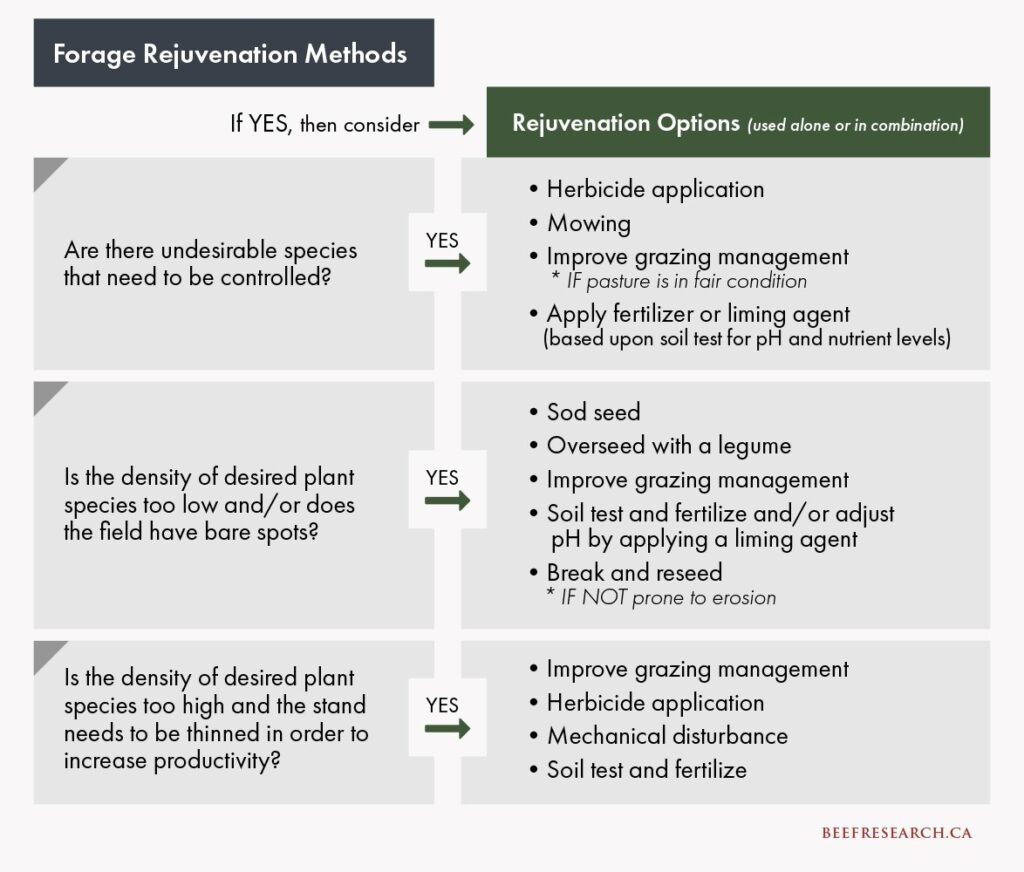
Rejuvenation methods can also be categorized by the action taken including management, manipulation, enhancement or replacement
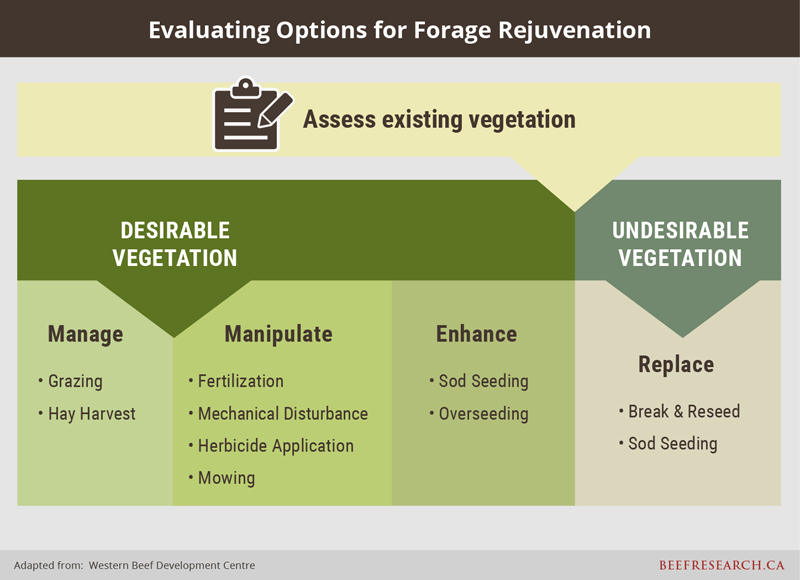
The following two videos from the Western Beef Development Centre provide an excellent overview of pasture rejuvenation considerations and options, including results from research trials. Specific treatments covered include break and reseed (Part 1 – 4:51), fertilization (Part 1 – 5:54), mechanical disturbance (Part 2 – 0:30), sod seeding (Part 2 – 3:34), overseeding with a legume (Part 2 – 6:22), and grazing management (Part 2 – 7:53).
The following chapter from the Maritime Pasture Manual on pasture renovation and rejuvenation provides information relevant to Atlantic Canada.
Watch the BCRC webinar, Practical Applications of Forage Rejuvenation, for an in-depth look at why to consider rejuvenation of a forage stand, things to consider and possible techniques (27:40) to achieve your goals.
Grazing
On pastures, grazing management directly affects stand health and should be the first rejuvenation technique considered. The need for rejuvenation is generally a signal that there are problems with the current management system. The number of animals (animal units), grazing frequency and the length of recovery time (rest period) directly influences forage stand decline and results in overgrazing. Until any grazing management issues are addressed, no other aspect of rejuvenation will maintain healthy stands.
| Until any grazing management issues are addressed, no other aspect of rejuvenation will maintain healthy stands. |
Often rest alone can be a simple and effective tool to rejuvenate stands. Providing rest to perennial forage plants through improved grazing management will increase their vigour and allow them to become more competitive with undesirable species.
In order to manage timing of grazing, frequency, intensity, and periods of rest, multiple paddocks must be used. Strategic fencing and access to water sources will allow for control of grazing pressure and livestock distribution. With rest and recovery employed, it may be possible to reverse a decline in forage stand health and see improvements. Reports from Ontario estimate that a 25-35% increase in pasture productivity can be easily achieved by sub-dividing pastures and allowing for appropriate rest times1.
Going back to the basics of forage stand management and implementation of a managed grazing system should be considered at regular intervals. Management practices need to be evaluated on an ongoing basis and adjustments made any time there are changes in forage health and vigour.
In some regions and under certain conditions, changes in pasture vegetation may not necessarily be an indicator of improper grazing management but rather attributable to natural succession of native plants. This is certainly the case when woody species are part of the potential natural community for a site2. Intensively managed grazing has been successfully used to control aspen regrowth in the parkland regions of Alberta and the Peace River region of British Columbia. In healthy aspen stands with high sucker density, forage production can be increased by as much as two-thirds with intensively managed grazing3.
Winter grazing (as well as planned and managed in-field winter feeding) can be a useful forage rejuvenation option. Grazing sites, whether using bale grazing or stockpiled grazing can be strategically located in order to distribute nutrients through manure and urine. At two sites in northern Alberta where forage productivity had declined on 15-year-old pastures comprised of meadow bromegrass and alfalfa, bale grazing consistently produced higher forage dry matter yield than other rejuvenation methods (including breaking and reseeding, grazing management, fertilization, manure application, and sod seeding)4. This increased production could be due in part to improved soil physical conditions (infiltration rate, soil moisture and compaction) and increased soil nutrients. Bales made with mature grasses with seedheads present may also help to reseed pastures, which can be beneficial or detrimental depending on the species composition. Bale grazing has also been successfully practiced at the AAFC Nappan Research Farm in Nova Scotia for the past ten years, with anecdotal reports of improved pasture quality.
Fertilizing forages can also be accomplished by winter feeding on forage stands. Rather than cattle being fed in corrals, feed is provided to animals on pasture or hay fields. In-field feeding provides savings in machinery and manure handling costs while forage production can be increased as a result of added nutrients5.
The Beef Research School video, Fertility Management in Pastures, discusses fertility impacts on forage productivity (0:37), fertility strategies (1:55), and bale grazing as a source of nutrients for pastures (2:34).
Fertilization and pH Amendment
If an assessment of the current forage stand shows that there is a sufficient quantity of the desired plant species still present, then fertilization can be an effective tool to reinvigorate and increase forage yields. By applying nutrients that are limiting, as determined by taking a soil test, forage production can be improved.
Soil pH should be accounted for in conjunction with fertilizer plans—in the event of low soil pH, nutrients may be present in the soil but unavailable for uptake by plant species. When soils are very acidic (pH less than 5.8), soil bacteria and nitrogen-fixing bacteria in legume stands are adversely affected and soil biological activity is reduced6. Additionally, raising the pH can reduce the solubility of aluminum and manganese, which can be potentially toxic to plants at high levels. Optimum nutrient uptake by most crops occurs at soil pH between 6.0 and 7.0. Low pH soils are common in Eastern Canada due to the underlying bedrock and soil types, and often require amendments every few years to offset the natural progression to a return to lower pH levels. Adjusting soil pH will increase the solubility of nutrients and allow them to become more available to plants. Adding fertilizer to low pH soils without pH amendment will not solve the problem of nutrient insolubility.
In those regions across Canada where acidic soils are a limiting factor for forage production, a common practice is to apply a material that contains some form of lime or an effective calcium carbonate equivalency (such as wood ash). Lime type should be selected based on your soil test; dolomitic lime should be selected if magnesium is required over calcitic lime. Contact your local extension staff or agronomic consultants if you have questions regarding which lime source is most suitable to your situation. When an application of lime is needed, the lime is most effective if it is incorporated prior to seeding or at least six months in advance when overseeding or sod-seeding. Lime should not be applied at the same time as fertilizer to prevent interactions with the fertilizer before incorporation in the soil. It may take one to three years to become fully effective, especially if it is not incorporated. On-farm demonstrations in Atlantic Canada have shown that applying lime to pastures can increase productivity up to 30% the year after application7.With this type of soil remediation, pH is improved, and less fertilizer will be required due to better availability of soil nutrients. As with all soil factors, soil testing is essential to determine whether the pH needs adjusting and the best and most cost-effective management practices to employ.
Adjustments of pH should be considered before fertilizer applications. At a soil pH of 5, only 50% of fertilizer applied is available to crops, compared to 80% with a soil pH of 6.
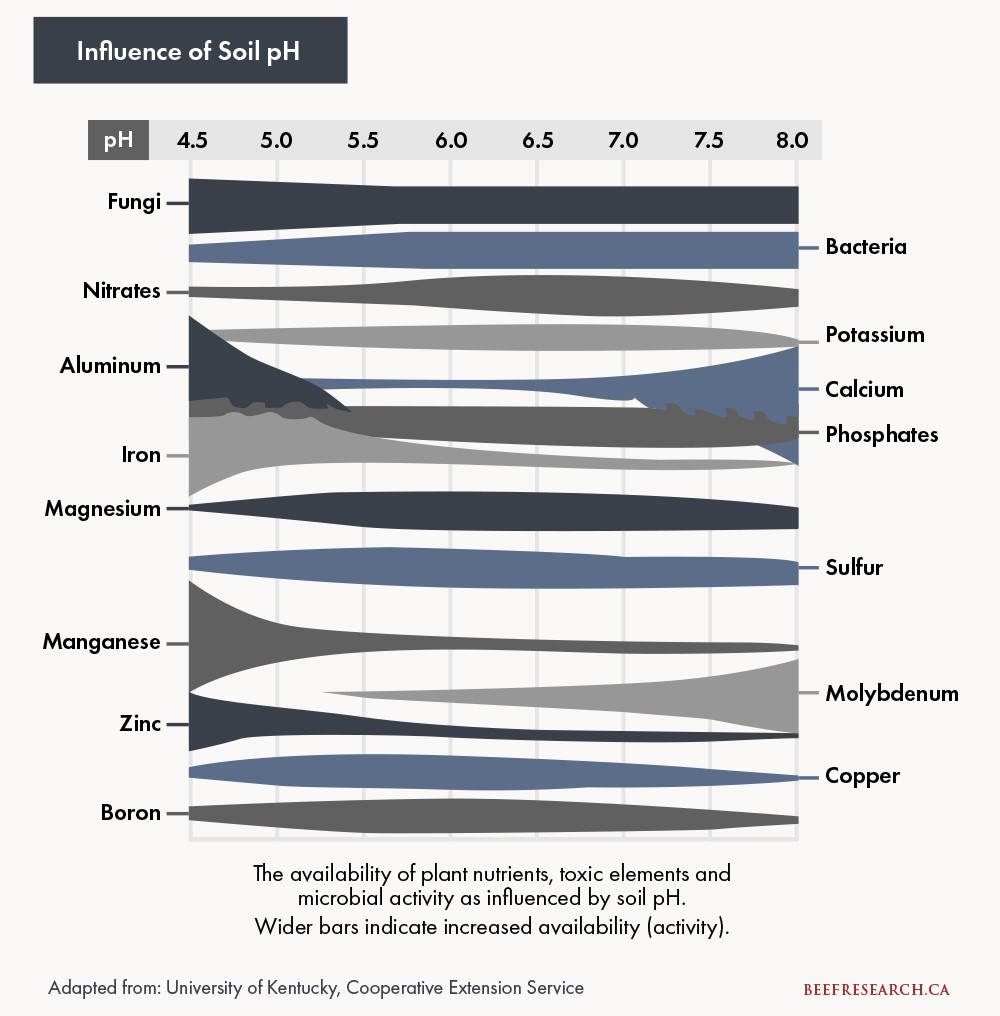
A soil test is also essential to determine which nutrients are currently available and which may be deficient. Without this critical information there is a good chance that your investment may be money misspent. Knowing what nutrients to apply and in what quantity is an important first step in a fertility program.
A soil test is essential to determine which nutrients are currently available and which may be deficient.
The use of fertilizer (inorganic) or manure (organic) to improve production and longevity should be based on recommended application rates considering fertilizer use efficiency, availability of nutrients in the soil, and soil moisture. Under the right conditions, fertilizer application can be one of the most cost-effective methods to improve forage yield and quality.
Nutrients applied will also depend on soil type and the type of vegetation. As general rule of thumb, grasses tend to be lacking nitrogen and phosphorous while legumes may benefit from the addition of phosphorous and sulfur. Fertilizer can be used to adjust the grass-legume ratio in a mixed stand with nitrogen application increasing the grass proportion and phosphorous increasing legumes. However, adding large amounts of nitrogen to fields with high legume content can cause legumes to significantly decrease or halt their own nitrogen fixation process—a very uneconomical occurrence.
It is usually better to band fertilizer below the soil surface than to broadcast in order to reduce nitrogen losses to the atmosphere and to increase the effectiveness of phosphorous due to its slow mobility in the soil5. Banding is best done when plants are dormant and when soil is moist to minimize plant injury because of root disturbance.
Application of granular fertilizer is very moisture dependent to break down the product and make it available. While some research suggests that fertilizer may not result in economic yield increases on dry years, most of the fertilizer, when banded, will remain in the soil and be available for future years8.
Application of granular fertilizer is very moisture dependent to break down the product and make it available.
Under irrigation, the use of fertilizer becomes much less risky as timing and amount of water applied can be managed. The potential for optimizing forage yields is very high as nutrient and moisture status can be controlled more closely as compared to dryland conditions where the outcome is dependent upon rainfall.
Research at the Western Beef Development Centre at Lanigan, SK found that, in general, response of tame pasture to application rates less than 50 lb/acre of actual nitrogen (N) tends to not cover off input costs. Therefore, depending on soil test results, rates of greater than 50 lbs/acre are likely required. Additionally, evaluation of four nitrogen application rates on tame grasses found that the greatest yield response to nitrogen was seen at a rate of 100 lbs/acre of actual N. At rates greater than 100 lb/acre actual N there was no added yield benefit.
A study conducted in western Quebec evaluated yield response of forage stands dominated by timothy and orchardgrass to four rates of N fertilizer9. On average, 112 lb/ac (125 kg /ha) of actual N was necessary to reach the optimum economic yield under the site conditions which included relatively cool soil conditions that likely restricted soil N mineralization in early spring. This shortage of soil N had to be compensated for by additional fertilizer to reach the optimal economic yield of these forage grasses.
Both of the above examples from different regions of the country present very generalized guidelines and emphasize the importance of evaluating each site, including soil conditions and forage types. In all cases, a soil test is needed to determine the optimum application rates for your specific soil type and forage species. In addition, split fertilizer applications are useful for timing nutrient delivery when the plants require it and reduces the amount of volatilization that occurs-– resulting in greater efficiency.
The following table reports yield response of several forage types to various fertilizer application rates across a number of soil zones and locations in Saskatchewan. Note the synergistic effect of applying more than one nutrient (nitrogen and phosphorous) with a two to three-fold increased yield response as compared to applying nitrogen alone.
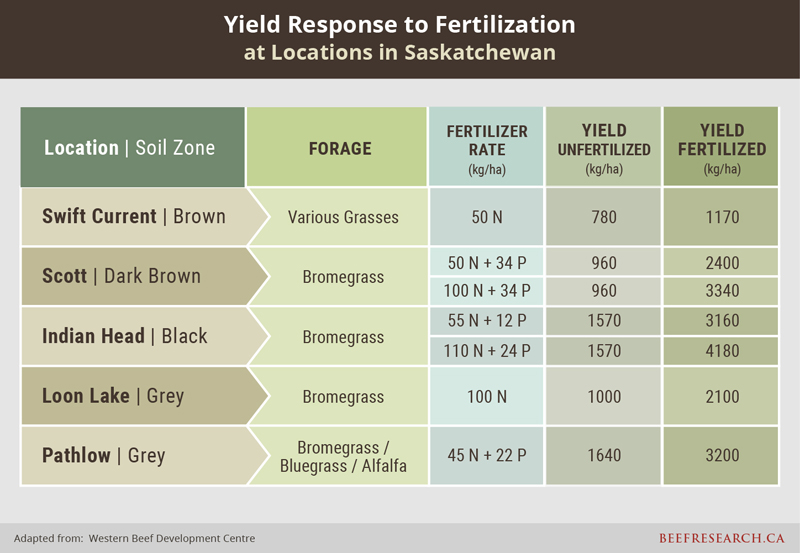
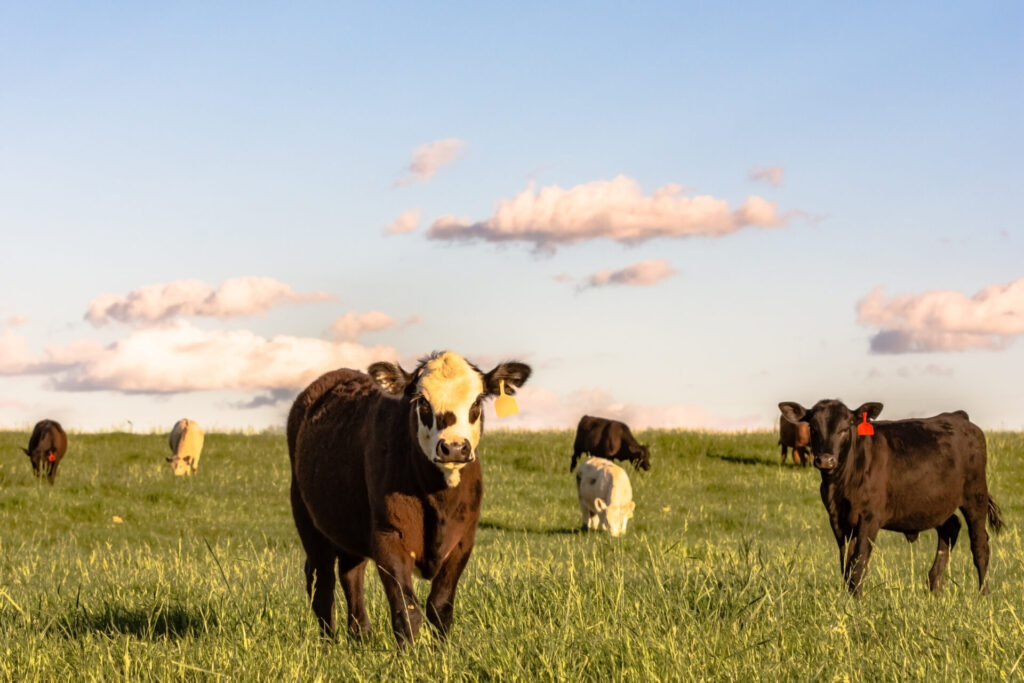
As with all rejuvenation treatments, costs and benefits of fertilization need to be carefully evaluated. The goal of fertilizing is to decrease the per unit cost of producing forage. However, higher yields do not necessarily translate into lower costs or increased profits due to fertilizer and application costs. Optimal fertilizer costs are affected by hay prices, fertilizer prices and the base land cost. As hay prices increase the willingness to pay for fertilizer should increase. As land costs increase the willingness to pay for fertilizer should increase. Inorganic fertilizer price increases may increase interest in maximizing manure usage. Inorganic fertilizer price increases may increase interest in maximizing manure usage. (Testing manure for nutrient content is one way to fine-tune nutrient management.) Therefore, it is important for producers to know their cost of production (COP) and adjust their strategy based on the current price situation.
The BCRC webpage, Improving Forage Yields, provides more detailed information about fertility and forage stands. To learn more about the economics and economic impacts of fertilization see the factsheet Historical Review of Forage Fertilization Research.
Mechanical Disturbance
Mechanical disturbance can be done using cultivator or anhydrous shanks, knives, or rotary harrows. Whatever type of equipment is used, the objective is to disturb 30 to 50 percent of the perennial forage stand to a depth of two to four inches using one or two passes in the early spring prior to plant growth. This will create a rough surface so the need to level the area using a drag or land roller after disturbance is likely.
This form of rejuvenation increases the decomposition of root material, releasing nutrients into the soil and making them available for plant use. With sufficient precipitation, the release of nitrogen will result in increased forage growth similar to applying fertilizer.
Although thinning of the stand and reduced forage production is seen initially, this method of rejuvenation may result in a longer-term increase in forage yield. However, disturbance of weed seeds can result in weed problems. It is important to note that using mechanical disturbance to improve forage production is very dependent on adequate moisture conditions.
Work at the Western Beef Development Centre at Lanigan, SK showed a 145% yield increase on crested wheatgrass pastures when a stand was spiked (minimal disturbance) in mid-April with a ¾ inch knife as compared to no disturbance10. When including nitrogen fertilizer along with the spiking treatment, there was a 202% yield increase with 50 lb N/acre and a 289% increase with the addition of 100 lb N/acre. In this study, treatments were very timely with spring rainfall contributing to positive growth response.
Studies conducted at five sites in central Alberta using an Aer-Way aerator for mechanical disturbance showed no significant yield response11.
Herbicide Application
Selective herbicides can be used to control unwanted plants (woody re-growth, brush expansion, poisonous and invasive plants) that are competing with desirable forage species.
Registered products are not available to control all species and some treatments may be expensive and difficult to apply. Several treatments of follow-up may be required for effective control and there is sometimes a risk of damaging or eliminating some desirable plants. Herbicide application may only provide a short-term solution as some weeds are indicators of soil pH, fertility or grazing management issues.
Herbicides can be applied using a regular ground sprayer where ground conditions allow. Wick applicators are effective for controlling weeds that are taller than the forage stand and can minimize the amount of herbicide applied which can be a cost saving measure.
A number of herbicides are registered for weed control in forage crops. Choosing the right herbicide for the job and circumstances is important as some products may require taking the area out of feed production for a period of time. Contact a regional agrologist for more information and specific recommendations for usage and application.
Mowing
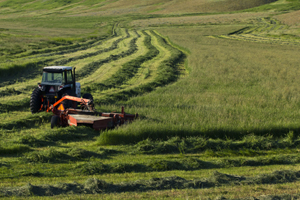
Mowing can be used to remove unwanted vegetation such as weeds or brush. The removal of these plants can provide a competitive advantage to the more desirable forage species, allowing them to make use of nutrients, sunlight and moisture and potentially outcompete the less desirable plants.
This method of rejuvenation is very hard on equipment when used on rough terrain and can be expensive and time consuming. Initially there is a reduction of the available forage but longer-term improvements in yield may be achieved. In the case of trees and shrubs, re-mowing is required as suckering and increased woody branches will occur. Mowing two years in a row is much more effective for woody plant control than only one mowing followed by another mowing several years later. Following mowing, cattle will browse new suckers of most woody species if stock density is high enough to reduce selective grazing.
Sod Seeding
Sod seeding is the direct seeding of forages into an existing perennial forage stand in order to improve species composition without breaking up the sod. In these situations, desired plant species densities have become too low and undesirable or invasive species too numerous in the stand. The use of a non-selective herbicide, such as glyphosate, is used to suppress existing and actively growing vegetation in order to allow for successful establishment of new seedlings. If not suppressed, the competition from the established plants, for both nutrients and soil moisture, will greatly reduce establishment of the new forage seedlings.
Remember, all remnant stands of native rangeland should be retained and NOT enhanced or replaced with non-native plant species. These areas should always be managed according to sound ecological principles.
The success of sod seeding is largely dependent upon adequate soil moisture and seed to soil contact to allow new seedlings to establish. Advantages of direct seeding into sod include not exposing the land to erosion as may occur with breaking and reseeding, conservation of available soil moisture that does exist, plus reduction in costs and the ability to keep fields in production. Additionally, soil fertility is important for any forage establishment method. Make sure to soil test fields prior to rejuvenation and apply fertilizer as required. Sites that lack potassium and phosphorus or are below a pH of 6 are likely not a good candidate for sod seeding without amendments in advance. Soil type may also impact the chances of success. Well drained, silty or loamy soils will likely have better results than clay soils.
The use of zero-till (no-till) seeding equipment is common when seeding annual crops but can also be used for sod seeding forages. The proper equipment will provide good soil penetration, seed-to-soil contact, and coverage on most soils, all of which are important variables in seedling establishment.
A project conducted by the Western Beef Development Centre (WBDC) compared different zero-till seed openers to sod seed alfalfa into grass stands. All of the openers tested worked well in this situation with similar alfalfa seedling establishment results when comparing treatments. More details on the results and use of zero-till openers are available in the WBDC factsheet, A Comparison of Zero-Till Seed Openers for Sod-Seeding Alfalfa for Pasture Rejuvenation and in the following video produced by the WBDC.
As the purpose of rejuvenation is improvement of forage quality and yield, the use of a legume is usually recommended. Alfalfa tends to be easy to establish; seedlings are vigorous, plants grow quickly, and the crop is quite adaptable to a range of soil and moisture conditions12. Anecdotal evidence from Eastern Canada has found that red clover establishes most easily in tall grass stands and is tolerant of shading. Other legumes including birdsfoot trefoil, sainfoin, and cicer milkvetch are slower to establish than alfalfa but provide a non-bloating, grazing tolerant forage source. Tame grasses are more difficult to establish when sod seeding into a stand where grasses are already present, but a legume-grass mix may work well for sites where the existing grass stand is thin.
A study of sod-seeded alfalfa and sod suppression at sites in Manitoba showed a dramatic difference in forage production between sprayed and non-sprayed areas, as suppressing the existing forage plants allowed alfalfa seedlings to take full advantage of available moisture13. At a second Manitoba location, sod suppression more than doubled forage production with newly established alfalfa as compared to non-sprayed sites.
In a semi-arid environment (Swift Current, SK), sod seeding alfalfa into grass stands that had strips sprayed out with a herbicide provided the most favourable results when considering forage production over three years following the treatment. Average daily gain for animals grazing the rejuvenated stand also showed the best results when sod seeding occurred as compared to fertilizer, spiking, or cultivated treatments. In a relatively dry location with lighter soils, this method allowed for maintenance of soil cover while still reducing the competition from established plants. As compared to cultivating and breaking a forage stand, the killed sod helped to retain moisture for new seedlings being established. Additionally, because strips were sprayed out rather than the entire stand, not all forage was taken out of production as is the case with breaking and reseeding.
At the same semi-arid prairie location, the effect of width of sprayed-out strips was also evaluated. Results showed a 50-centimetre width with seed placed directly in the centre of the strip as having the best establishment and dry matter production three years after the treatment. Production of the existing and adjacent crested wheatgrass and newly seeded alfalfa was good while weeds were minimized.
Intentional overgrazing to suppress plants and reduce competition has been used but is less successful than herbicide. If using extreme grazing pressure in the season prior to sod seeding, careful management must occur to avoid eliminating desirable species. Research at Lacombe, Alberta found that intensive grazing the year before sod seeding alfalfa or cicer milkvetch into a bluegrass dominated pasture was not enough to sufficiently reduce competition14. However, on bromegrass dominated sites this technique was more successful. A study in Quebec using sheep to graze a smooth bromegrass/reed canarygrass pasture both prior to sod seeding red or white clover and in the two months following seeding, resulted in similar densities of clover as compared to a 2.9L/acre application of glyphosate two weeks before seeding. However, longer term competition from the existing stand was better controlled by glyphosate than grazing and as a result clover yields and quality tended to be higher when glyphosate was used for suppression as compared to grazing15.
The BCRC webinar, Practical Applications of Forage Rejuvenation, provides an overview of a number of rejuvenation options with a focus on successes observed using sod seeding on relatively dry sites at Swift Current, Saskatchewan (32:50).
For a more in-depth look at sod seeding options, including suppression, seeding logistics and types of equipment, refer to the publication by the Manitoba Forage & Grassland Association and their partners, “Sod Seeding: Seeding forages into existing stands using minimal tillage”.
Overseeding of Legumes
The objective of introducing a legume into an existing low plant density forage stand can be achieved by broadcasting seed followed by a harrow, roller, and/or graze to encourage seed-to-soil contact and incorporation of the seed into the sod to increase germination success. Grass seeds usually do not perform as well as legumes due to their lighter density and seed shape which can reduce seed-to-soil contact.
The success of overseeding is largely dependent upon reduced competition from already established plants. For this reason, fertilizing when overseeding is not recommended as added nutrients will also be used by plants already in the stand, increasing the competition for new seedlings. If fertilizer will be applied, it is recommended not to apply nitrogen which will promote grass growth and competition.
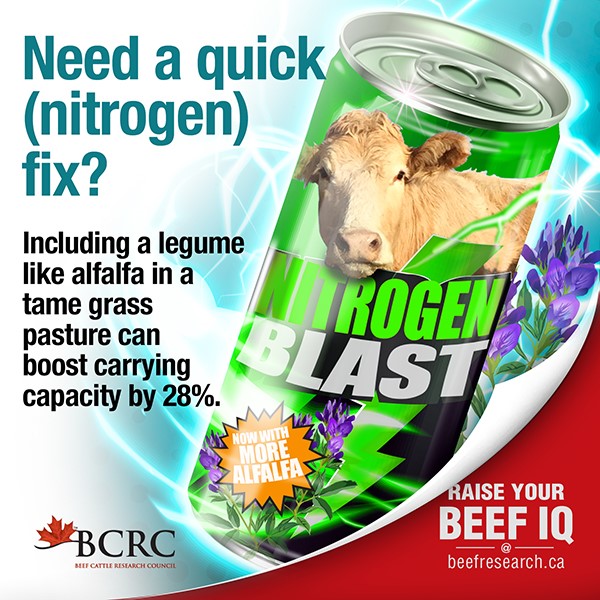
Overseeding is a relatively inexpensive rejuvenation technique however, establishment success is highly dependent upon favourable conditions. Low density stands or overgrazed pastures will have a much better chance for establishment success as compared to stands where established forage is already quite dense. Careful grazing during the year of establishment can also help increase the chances of legume establishment by reducing grass competition. As always, allowing appropriate rest is essential to ensure proper recovery. Adequate moisture is also critical for legume establishment when overseeding. Overseeding can be done at several timepoints during the year but early spring is often a good choice due to the reasonably reliable moisture expected and relatively lower biomass in fields which may encourage improved seed to soil contact.
Frost seeding is a technique that has been used successfully mainly in parts of Eastern Canada to introduce primarily legumes into an existing forage stand in areas where the terrain or stones limit use of large seeding equipment16. Forage seed is broadcast in the winter on top of snow or early spring when frost is still occurring. The effect of the snow melt helps carry the seed down to the soil surface and alternate freezing and thawing of the ground heaves the surface allowing the seed to be incorporated into the soil. Legumes are more successful with this seeding method as they tend to be denser than grass seed and they germinate at lower temperatures which allows for growth to occur early in the spring17. Establishing grasses with frost seeding is much less successful as they are less dense and tend to remain on top of the soil delaying growth until warmer temperatures arrive which often coincides with drier weather. The cost of equipment is low, but seedling mortality is high resulting in higher risk for establishment success. Similar to other rejuvenation techniques, adequate moisture is very important for frost seeding to result in forage establishment.
Some producers have successfully used livestock as a low-cost way to introduce new legume plants into a pasture stand. If livestock are fed legume seeds by adding to a grain or mineral mix some “hard” seeds will remain viable as they pass through the digestive tract. The seeds pass through the animal but will not germinate in freshly excreted manure. As the manure breaks down and becomes distributed on the soil some intact seeds may germinate. Seeds need to be raw and undamaged, untreated and with no mechanical injury or scarification from harvest. The successful of this method is variable and produces a very non-uniform stand as random seedlings do establish. One Ontario study found that only 10% of seeds will germinate when seeded this way. However, depending on the location and condition of the pasture, it may be the most viable option for reseeding18.
Whether sod seeding or overseeding legumes into an existing forage stand, the following benefits can be achieved if establishment is successful:
- eliminating or reducing the need for nitrogen fertilization as the legume will fix nitrogen and provide for requirements of grass plants within the stand
- increased forage quality with higher protein content which results in improved grazing animal performance
- improved seasonal distribution of forage growth through the growing season as legumes are more productive during mid-summer as compared to cool-season grasses.
Producers discuss their experiences and the value of including legumes in pastures, whether when establishing a new stand or through rejuvenation, in the following video from Alberta Agriculture and Forestry.
Break and Reseed
The most traditional yet drastic approach to rejuvenation has been to terminate the existing stand using a non-selective herbicide such as glyphosate, followed by tillage and reseeding. This method requires a longer-term time commitment and is typically used when undesirable plants such as invasive or woody species have encroached upon a pasture and the density of desirable plants is quite low. Often an annual cereal crop such as oats or barley is grown during the first year followed by the establishment of forage species in the second year.
A significant drawback to breaking and reseeding an established stand is the loss of production in the initial year. If moisture conditions are not favorable, it can take more than one year to re-establish the forage stand. Other challenges include the potential for erosion and loss of soil moisture when tillage and establishment of the new stand occurs. The costs of re-establishing a stand are significant as field operations include tillage, seedbed preparation and seeding. One must also consider access to the right equipment.
Advantages to this method of rejuvenation include the potential release of soil nutrients for use by the following crop. This is also an opportunity to spread and incorporate liming soil amendments to improve pH of fields. If the objective is a complete change to the forage stand including removal of undesirable species or a shift from one forage type to another (grass to legume or grass-legume mix) then breaking and reseeding may be the most viable option.
With any method of seeding forages, proper seedbed preparation is important. A firm seedbed prior to seeding allows for better control of seeding depth and seed-to-soil contact. A good rule of thumb for firmness is that a boot print in the soil should not be more than a ¼ inch (6mm) deep. Loose soil can result in excessive seeding depths.
The Forage Establishment page and Forage U-Pick tool provides more information specific to reseeding of forage species if this rejuvenation technique is used.
A detailed overview of the important steps in establishing a high-legume pasture is presented in the following video developed by Alberta Agriculture and Forestry.
Evaluating Costs and Benefits of Rejuvenation Options
The estimated cost to rejuvenate a forage stand is relatively simple to calculate using published average custom and equipment rental rates plus price of inputs (i.e., herbicide, fertilizer, seed). Benefits are more difficult to predict as yield responses may be quite variable. However, estimates can be used to determine potential increases in productivity.
A study conducted at two sites in Alberta tested a variety of methods and evaluated the economics of rejuvenating the productivity of low producing forage stands. The factsheet, Best Methods for Pasture Rejuvenation, prepared by Alberta Beef Producers and the Alberta Beef, Forage & Grazing Centre, provides an excellent summary of what they learned including challenges when trying to rejuvenate pastures in a low moisture situation.
Acknowledgements
Updates to this page were completed in collaboration and with the expertise of staff at Perennia Food and Agriculture.
- References
-
1 Kyle, Jack. 2014. Pasture Opportunities. Ontario Ministry of Agriculture, Food and Rural Affairs.
2 Dobb A. and S. Burton. 2013. Rangeland Seeding Manual for British Columbia. B.C. Ministry of Agriculture, Sustainable Agriculture Management Branch, Abbotsford, B.C.
3Bork, E.W., D. Gabruck, and B. Klein. 2008. Trembling aspen: Comparative strategies to manage aspen in Canada’s Parkland. Greencover Canada Program.
4 Omokanye, A., C. Yoder, L. Sreekumar, L. Vihvelin, and M. Benoit. 2018. Forage production and economic performance of pasture rejuvenation methods in northern Alberta, Canada. Sustainable Agriculture Research 7: 94-110.
5 Jungnitsch, P., J.J. Schoenau, H.A. Lardner, and T. Highmoor. 2005. The effect of winter feeding systems on nutrients, forages, cattle and economics. Soils and Crops Workshop.
6 Fears, R. 2015. The value of liming low-pH soils. Progressive Forage.
7 Nova Scotia Agricultural College. No date. Liming Pastures.
8 Saskatchewan Soil Conservation Association. Rejuvenating Forages.
9 Ziadi, N., R.R. Simard, G. Allard, and G. Parent. 2000. Yield response of forage grasses to N fertilizer as related to spring soil nitrate sorbed on anionic exchange membranes. Can. J. Soil Sci. 80:203-212.
10 Lardner, H.A., 1998. Rejuvenation of Crested Wheatgrass. Western Beef Development Centre factsheet.
11 Mahli, S.S., K. Heier, K. Nielsen, W.E. Davies, and K.S. Gill. 2000. Efficacy of pasture rejuvenation through mechanical aeration or N fertilization. Canadian Journal of Plant Science 80:813-815.
12 Manitoba Agriculture, Food and Rural Initiatives. 2006. Sod-Seeding into Existing Forage Stands.
13 Manitoba Agriculture. Improving Survival of Sod-Seeded Alfalfa.
14 McCartney, D., M.P. Schellenberg, F. Stewart, and C. Stevens. 2007. Sod seeding methods for rejuvenating grazing lands in the Aspen Parkland of Western Canada. Final Report, Agriculture and Agri-Food Canada, Lacombe, AB.
15 Seguin, P. P.R. Peterson, C.C. Sheaffer, and D.L. Smith. 2001. Physical sod-suppression as an alternative to herbicide use in pasture renovation with clovers. Canadian Journal of Plant Science 81:255-263.
16 Stewart, F. 2004. Options for Improving Forage Production on Pastures and Hay Lands. Manitoba Forage Council.
17 Kyle, J. 2009. Frost Seeding – A Cheaper Alternative. Ontario Ministry of Agriculture, Food and Rural Affairs.
18 Thomas, Bill. 2021. Improving Pasture and Hayfields by No-Till Interseeding. Perennia Food and Agriculture Inc factsheet.
Feedback
Feedback and questions on the content of this page are welcome. Please e-mail us.
Expert Review
This content was last reviewed December 2022.
This content was last reviewed June 2023.
